Choosing the Best Wetsuits for Easy Use in Kiteboarding

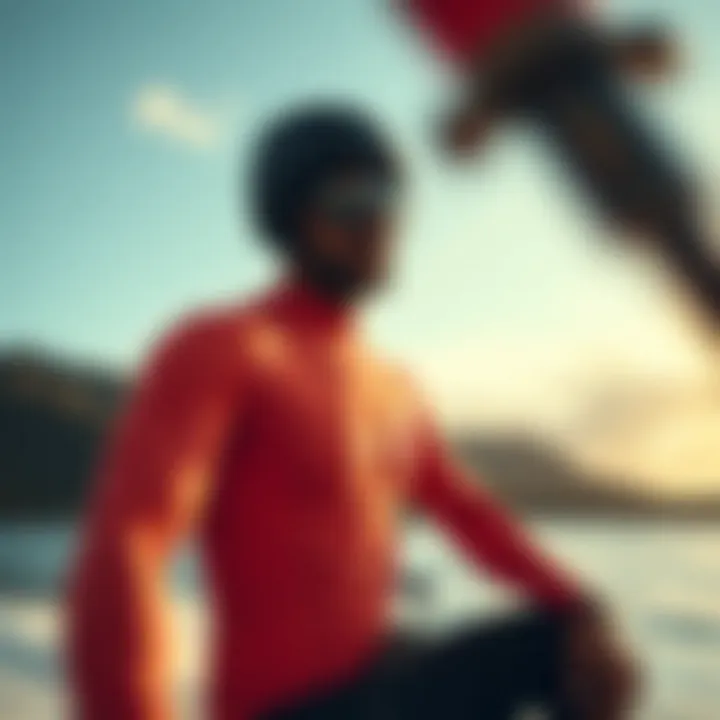
Intro
When it comes to kiteboarding, comfort and performance go hand in hand. One core piece of equipment that can significantly impact your experience is the wetsuit. For novices and seasoned kiteboarders alike, finding a wetsuit that is both easy to put on and take off can make the difference between an enjoyable session and a frustrating struggle. This article will delve into the world of wetsuits with the aim of helping you choose the best fit for your kiteboarding adventures.
In this guide, we will break down the essential elements to consider when selecting a wetsuit, such as material, design, and user-friendly features. Our goal is to highlight what enhances ease of entry and removal, ensuring you spend less time wrestling with your gear and more time riding the waves.
Gear Insights
Latest Gear Reviews
The market is awash with wetsuits, ranging from entry-level options to high-end products suited for serious kiteboarders. Here are some top picks that are getting noticed for their user-friendly attributes:
- O'Neill Hyperfreak: Known for its stretchy material and ease of getting on, this wetsuit offers a comfortable fit without feeling restrictive. Plus, the front zipper design means it can be removed quickly.
- Rip Curl Flashbomb: This suit stands out due to its quick-drying capability and minimalist design. It features an easy entry system that appeals to those who prefer a hassle-free experience.
- Mystic Marshall: Another great options, especially for colder waters. The wetsuit’s flexibility coupled with its zipperless entry can feel like a luxury when you're in a rush to get out and ride.
Essential Gear for Beginners
If you’re new to kiteboarding, picking the right wetsuit can feel overwhelming. Here are some crucial tips:
- Look for wetsuits with a smooth interior lining. This typically makes them easier to slip on.
- Prioritize suits with front zippers over back zippers. Front zippers often provide more freedom of movement.
- Opt for wetsuits that offer thermal insulation without excess bulk. You want to stay warm, not weigh yourself down.
A well-fitted wetsuit can dramatically improve your kiteboarding experience. Not only will it keep you warm, but it will also protect you from wind and the elements.
Understanding Wetsuit Materials
Different wetsuit materials bring various advantages. Here are the most common types:
- Neoprene: A staple in wetsuits, neoprene offers good insulation and is stretchy, allowing for flexibility.
- Yamamoto Neoprene: A more advanced option, this material is lighter and offers better thermal retention, but at a higher price.
- Limestone Neoprene: Produced from eco-friendly sources, this offers the same performance as standard neoprene but with a lower environmental impact.
When it comes to sizing, finding balance is key. A wetsuit that's too tight can feel like a vice grip, while one that's too loose won’t keep you warm. Always remember to consult the sizing charts provided by brands, as they often vary.
In the next sections, we will explore techniques and tips for making your kiteboarding sessions even more enjoyable while ensuring you have the right gear.
Prelims to Wetsuits
Wetsuits are essential gear for water sports enthusiasts, especially those who find themselves tackling the waves while kiteboarding. Understanding the role of wetsuits goes beyond just knowing how to put one on; it's about grasping their significance in comfort, protection, and performance. Kiteboarding can be exhilarating, but the chill of water can quickly dampen spirits if one isn't adequately equipped. Here, we’ll explore various elements that make wetsuits vital for kiteboarders, focusing particularly on their purpose and how they function.
Purpose of Wetsuits
At their core, wetsuits serve a simple yet crucial purpose: to keep the wearer warm. However, their benefits don't stop there. Wetsuits help regulate body temperature, which is essential when participating in water sports, especially in colder climates. They are designed to trap a thin layer of water between the suit and the skin, which subsequently warms up due to body heat. This innovative design helps in insulating the body, allowing riders to extend their sessions without the nagging chill setting in.
Additionally, wetsuits provide a protective barrier against abrasions, stings, and increased buoyancy. For example, when kiteboarding, falling onto a shark-infested reef or a sharp piece of equipment could lead to nasty cuts. So, wearing a wetsuit is crucial to mitigate such risks.
In summary, wetsuits are not just about warmth; they enhance safety, buoyancy, and overall comfort during water activities.
How Wetsuits Function
Wetsuits operate on the principles of thermodynamics and buoyancy. When worn, the suit clings tightly to the body, allowing minimal water to enter. As mentioned earlier, this small amount of water is warmed by the body, turning the wetsuit into an insulating layer. The thickness and material quality of the wetsuit significantly affect how well it performs—thicker neoprene offers more insulation but may be harder to put on and take off, while thinner suits provide less warmth but are often easier to manage.
Most wetsuits are made from neoprene, a type of synthetic rubber that is flexible and durable. Various entry systems further enhance functionality:
- Back Zip: A classic design with a zipper running down the back, offering easy access but can be tricky for self-donning.
- Front Zip: More streamlined and allows for better flexibility, though some djustability may be compromised.
- Chest Zip: Popular among serious water sport enthusiasts, this design allows for minimal water entry and is often touted for the ease of movement it provides.
"The right wetsuit can make all the difference in how much fun you have out there. It’s not just gear; it’s your second skin."
By considering these factors, kiteboarders can select the most suitable wetsuit that aligns with their needs. The design not only affects performance but also lays the groundwork for ease of use.
Importance of Accessibility
Accessibility in wetsuits goes beyond just a simple task of getting them on and off. It’s about ensuring that kiteboarders can maximize their time enjoying the water, instead of fumbling with complicated zippers or stiff materials.
Why Ease of Use Matters
When it comes to kiteboarding, every moment counts. The wind can change in an instant, and that perfect wave might not wait for a difficult wetsuit to cooperate. Wetsuits that are easy to wear save valuable time and energy. For instance, a wetsuit that features a back zip closure can be put on quickly, allowing you to hit the waves sooner. Conversely, struggles with a cumbersome suit can lead not only to frustrations but ultimately, a missed experience.
Consider how time spent fighting with a wetsuit could be better utilized for checking gear, assessing wind conditions, or simply stretching before a ride. Moreover, ease of use promotes greater self-sufficiency, especially for beginners who may already feel overwhelmed. A suit that slips on effortlessly can build confidence, inviting new riders to embrace the sport with open arms and less hesitation.
User Experiences
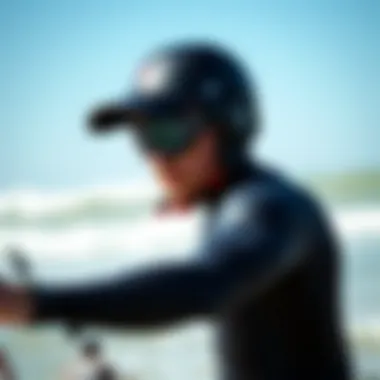
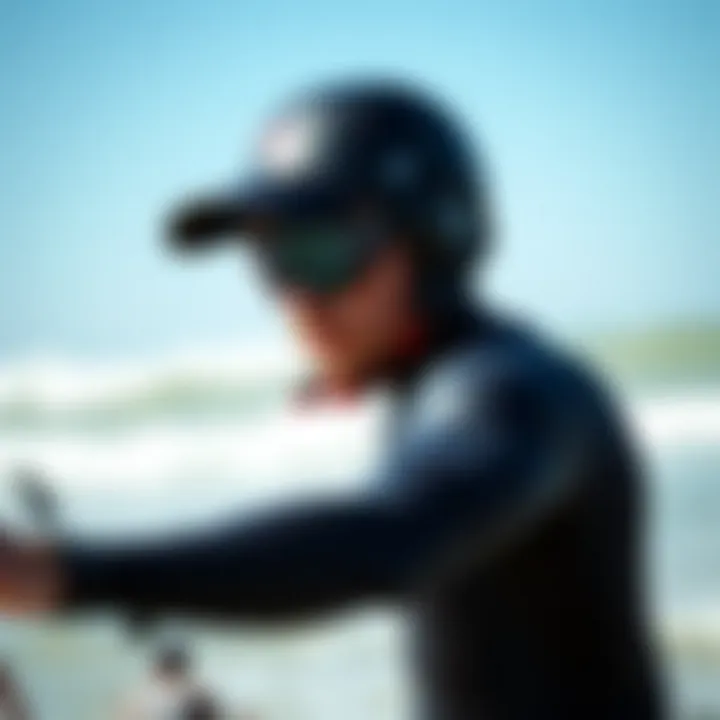
■ Many users highlight the value of comfort and accessibility. Convenience is often reported as a key factor influencing brand loyalty. Those who have tried suits from various manufacturers usually point out notable differences. Some suits, like those by Xcel, are praised for not just the flexibility but also the ease with which they can be donned and doffed. Others, however, may recount tales of wrestling on the beach, battling with stubborn zippers or materials that just stick to the skin.
"I’ve had wetsuits that felt like I was putting on a second skin, and others where my arms were practically immobilized. No contest in terms of fun when you can actually move!"
The stories vary, but the common thread always returns to ease of access. Veteran kiteboarders often share their own journeys of trial and error, finding the right fit among a sea of choices.
In summary, accessibility in wetsuits isn’t merely about getting into them; it’s also about enriching the overall kiteboarding experience. Whether you’re a seasoned pro or just stepping into this thrilling aquatic adventure, the right wetsuit can make or break your day on the water.
Key Features of Easy-On Wetsuits
Selecting a wetsuit that is easy to put on and take off is pivotal for kiteboarders who wish to maximize their time on the water without the hassle of complex gear adjustments. A wetsuit's design encompasses several elements that contribute to accessibility, comfort, and overall user satisfaction. Understanding these key features is crucial for both novice and experienced kiteboarders looking to enhance their experience while minimizing frustration.
Ease of access often hinges on the wetsuit's entry system and the materials used in its construction. Let's break down the specific features of these easy-on wetsuits to help guide your choices.
Entry Systems
Back Zip
The back zip is a classic design that many kiteboarders are familiar with. This system allows for a straightforward entry into the wetsuit, thanks to a zipper that runs down the back, making it relatively easy to get into. The primary characteristic of the back zip is its accessibility; it can often be operated by the wearer alone. Plus, it's a popular choice when it comes to warmth retention, as the zipper layout helps to minimize water entry.
However, while the back zip offers ease, it can also have some drawbacks. Some users find that the zip might create an uncomfortable sensation along the spine or that it is prone to getting stuck if not maintained properly.
- Advantages:
- Disadvantages:
- Simple entry and exit
- Good for warmth
- Can feel uncomfortable
- Requires maintenance to ensure zipper function.
Front Zip
Jumping into the front zip wetsuits, these are known for their innovative design that focuses on user experience. Positioned at the chest level, the zip allows for increased flexibility in movement, which can be a divine advantage for kiteboarders who need to maintain a full range of motion. The front zip also tends to fit snugly, creating a water-tight barrier while being elegant to wear.
Despite these pluses, entering a front zip can require some technique, making it slightly less intuitive than the back zip for some users. Still, the overall feel is often much more streamlined and less cumbersome.
- Advantages:
- Disadvantages:
- Greater freedom of movement
- Tight fit reduces water entry
- May need a bit of practice
- Can be more complex to put on compared to back zips.
Chest Zip
This type of system is rapidly gaining popularity among serious kiteboarders. The chest zip wetsuits feature a zipper that lies across the chest, allowing for a super snug fit and substantial flexibility. The defining characteristic here is its ability to minimize water entry significantly, as there is no direct opening along the larger back or front sections.
Taking into account the unique construction, putting on a chest zip wetsuit is generally more challenging than the other two entry systems. However, for those who value an excellent fit and low water ingress while kiteboarding, this suit is gold.
- Advantages:
- Disadvantages:
- Excellent fit and water protection
- High maneuverability
- Can be tricky to put on
- Might require assistance, particularly for beginners.
Material Choices
Neoprene Flexibility
When it comes to wetsuits, neoprene is the fabric of choice. Its flexible nature provides unparalleled ease of movement, particularly important in kiteboarding where agility is critical. High-stretch neoprene not only makes it easier to slip on and off, but it also molds to the body, offering a comfortable fit while minimizing excess material that can lead to discomfort.
The flexibility of neoprene means that users can move freely without restriction, which can enhance performance while out on the waves. However, the trade-off can be durability; thinner neoprene may not withstand rigorous use as well as thicker alternatives.
- Advantages:
- Disadvantages:
- Exceptional flexibility
- Comfortable fit
- Less durable with heavy use
- Thinner versions may wear out quickly.
Thickness and Warmth
Thickness plays a pivotal role in a wetsuit's overall warmth and comfort. Wetsuits come in various thickness levels, usually measured in millimeters. Thicker suits provide better insulation but can often be stiffer and challenging to wear.
For kiteboarders, a balance must be struck; too much thickness can limit movement, while too little can leave you shivering in the water. A common choice is a wetsuit that offers a moderate thickness, providing warmth without sacrificing flexibility. Be mindful of the conditions you'll be in, as that will heavily influence the thickness you choose.
- Advantages:
- Disadvantages:
- Increased warmth and insulation
- Greater comfort in colder waters
- Limited flexibility in thicker suits
- May not be suitable for warmer climates.
By harmonizing the right entry system with proper material choices, kiteboarders can find a wetsuit that offers not only comfort and ease but also performance on the water. This makes for a more enjoyable experience as you soar through the waves without the distraction of an ill-fitting suit.
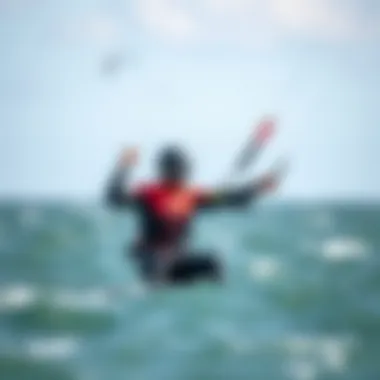
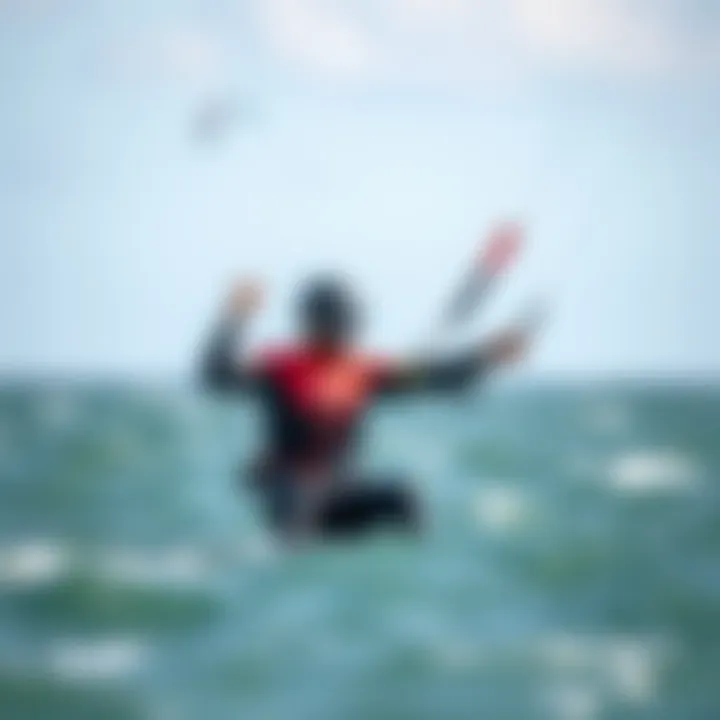
Comparison of Brands and Models
Choosing the right wetsuit can feel like finding a needle in a haystack, especially with the variety of options available. Not every brand will cater to your specific needs as a kiteboarder, and that’s where a thorough comparison of brands and models proves invaluable. By analyzing various brands side by side, we can draw critical lessons on quality, performance, and fit.
This article focuses on several popular brands and their models, providing insights into their strengths and weaknesses. This comparison will not only help readers identify which wetsuit might be their best fit but will also guide them to make a more informed decision based on user feedback and unique characteristics unique of each brand.
Top Brands Overview
Brand A Analysis
Brand A is renowned for its affordability. It's a go-to choice for newbies who are just dipping their toes into kiteboarding. One of the standout features is its incredibly flexible neoprene, allowing for good mobility without losing warmth. The ease of putting it on and taking it off is often praised by users, making it a popular pick for those just starting out. However, durability tends to be a concern, with some users reporting wear and tear after just a few seasons.
Key Characteristics:
- Flexibility: Excellent range of motion.
- Affordability: Great for beginners or budget-conscious kiteboarders.
Unique Features:
Brand A incorporates a unique glide skin on the inside, which not only improves comfort but also makes donning and doffing the suit a smoother process. The downside is that this feature might result in less warmth retention.
Brand B Analysis
Brand B positions itself as a premium option in the market. It focuses heavily on performance, with several high-end models crafted for seasoned kiteboarders who demand the best. One notable aspect is its seamless construction, which significantly reduces water entry and enhances warmth—key for those longer days on the water.
Key Characteristics:
- Performance: Excellent thermal retention.
- Seamless Construction: Higher durability and lower water entry.
Unique Features:
The brand has developed a hydro-dynamic outer layer that cuts through water, improving speed and performance. However, this premium comes with a price tag that may deter casual users, making it less accessible for the average kiteboarder.
Brand Analysis
Brand C merges technology with style, attracting kiteboarders who care about aesthetics as well as function. Users often rave about the stylish designs that don’t compromise on performance or comfort. One major attribute is quick-drying material, which is a game changer. Kiteboarders will appreciate stepping out of the water and not ending up in a damp suit.
Key Characteristics:
- Stylish Designs: Attractive and functional.
- Quick-Drying Material: Ideal for those who move in and out of the water often.
Unique Features:
Brand C’s minimalist yet functional pockets enhance convenience without adding bulk, making them ideal for keeping essentials close at hand. On the flip side, though, some users note that their sizing tends to run small, which can be a headache for those with unexpected fit issues.
Model-Specific Features
Model A Highlights
Model A offers a flexible design tailored for quick movement, making it an ideal choice for experienced kiteboarders who perform agile maneuvers. It’s lightweight and allows for easy transitions in and out of the water. Users have noted the snug fit as one of its winning features, effectively retaining heat while providing comfort.
Key Characteristics:
- Lightweight Design: Perfect for high activity.
- Snug Fit: Retains heat without feeling restrictive.
Unique Features:
An innovative internal lining allows for extra warmth while being easy to get on. Users consistently mention the suit’s impressive breathability during intense activities. However, it sometimes runs a bit on the pricey side compared to others.
Model B Highlights
Model B is notable for its impeccable thermal properties, making it a strong candidate for colder waters. Users often highlight its insulation as a pivotal feature, allowing extended kiteboarding without chills setting in. However, given its thicker material, some kiteboarders have cited issues with mobility, especially for more acrobatic moves.
Key Characteristics:
- Excellent Insulation: Great for cold water conditions.
- Extended Use: Keeps body heat for longer durations.
Unique Features:
The added knee pads provide safety without sacrificing flexibility or comfort. Still, the thickness can make it a challenge to don and doff quickly, which is crucial after an adventurous session.
In sum, the comparison of brands and models serves crucial for kiteboarders seeking an easy-to-wear wetsuit, reflecting user experiences and decisions made for both novices and veterans in the sport.
User Feedback and Reviews
User feedback is the backbone of understanding how different wetsuits perform in the real world, especially for kiteboarders who want something that doesn't hinder their sessions. It’s not just about how the wetsuit looks on the hangar; it's about how it feels in action. Reviews can illuminate features that might not be obvious during a basic inspection but are crucial when it comes to usage. Moreover, understanding what real users have experienced can save new enthusiasts a lot of headaches, ensuring they invest their money wisely.
The benefits of leaning into reviews are multifaceted. For starters, they provide invaluable insights into comfort and fit, elements that can make or break a kiteboarding experience. Beyond that, users often bring up the durability of the materials, how well they hold up against saltwater, and how easy they are to put on and take off. A wetsuit might be marketed as user-friendly, but firsthand accounts can act as a reality check.
Another major consideration is the diverse range of experiences shared, which can cater to a broad audience – from beginners to seasoned pros. This way, potential buyers can gauge how well different suits might meet their individual needs and circumstances, making their decision less daunting.


Feedback Collection Methods
Effective feedback collection is paramount to getting a comprehensive view of any product, including wetsuits. Here are some methods often employed to gather user experiences:
- Surveys and Questionnaires: Some brands actively seek feedback through structured surveys sent out to their customers. These surveys typically inquire about specifics like comfort, ease of entry, warmth, and durability.
- Social Media Platforms: Platforms like Reddit and Facebook are goldmines for organic feedback. Users often share their honest thoughts and experiences regarding specific wetsuit models, fostering a sense of community among water sports enthusiasts. The discussions range from minor gripes to game-changing recommendations, especially in niche groups related to kiteboarding.
- Product Reviews on E-commerce Sites: Websites that sell wetsuits often display customer reviews. These reviews can range from a single star to glowing reassessments, providing potential buyers with a well-rounded perspective on what they might expect. Importantly, these platforms frequently have built-in systems to identify verified buyers, adding credibility to the feedback.
- Testimonial Compilation: Some companies might compile feedback from customers into case studies or testimonials, highlighting standout features. These are often crafted from sound bites taken from existing reviews, serving as marketing material but still retaining authentic user sentiment.
By gathering feedback through diverse channels, brands cultivate a reservoir of knowledge that not only informs product improvement but also helps consumers make well-rounded choices.
Common Complaints
No product is without its shortcomings, and wetsuits are no exception. Listening to common complaints can uncover recurring issues that individuals face, enabling potential buyers to tread carefully. Here are a few common complaints that often crop up:
- Difficulty in Entry: While some wetsuits pride themselves on ease, several users report struggling to get into their suits, particularly with back zip designs that can be cumbersome. This can be notably frustrating after a long day of kiteboarding, where quick changes are often necessary.
- Chafing and Discomfort: Many users complain about chafing in areas like the neck and underarms. This can be especially challenging in a sport like kiteboarding, where prolonged movements can irritate the skin.
- Water Infiltration: A few reviewers have pointed out that certain models are less effective at keeping water out than advertised. Inefficiencies in seals or zippers can lead to discomfort, particularly in colder waters, thus negating any thermal advantages.
- Sizing Issues: Fit can be an elusive parameter. Some riders find that the size they typically wear doesn’t translate well between brands. Additionally, variations in individual body types can lead to mismatches that frustrate many customers.
Therefore, familiarizing oneself with these potential issues is crucial for kiteboarders looking to purchase a wetsuit that complements their activity rather than hinders it. Armed with this knowledge, they can sift through options more efficiently, honing in on suits that stand a better chance of meeting their needs.
How to Choose the Right Wetsuit
Selecting the right wetsuit is a crucial step for anyone venturing into the world of kiteboarding. A suitable wetsuit not only enhances your comfort on the water but also ensures optimal performance while providing protection against the elements. Knowing how to choose the right wetsuit can mean the difference between a thrilling ride and an uncomfortable experience, especially for beginners.
In this segment, we will illuminate key factors that should guide your selection process—from fit to fabric choice. A well-chosen wetsuit should feel snug against your body without constricting movement. Understanding various elements allows you to make an informed decision, ultimately enriching your kiteboarding adventure.
Assessing Fit and Comfort
When it comes to comfort, fit is king. A wetsuit that’s too loose will let cold water seep in, leaving you shivering like a wet cat. Conversely, if it’s too tight, you risk feeling restricted, leading to a less enjoyable experience. Ideal fit involves several nuances:
- Body Shape: Wetsuits come in different cuts to accommodate various body types. For example, women often need suits designed with their proportions in mind, providing a better overall fit.
- Thickness: A suit’s thickness can also affect comfort. Generally, thinner neoprene materials offer greater flexibility but less warmth. If you’re kiteboarding in warmer waters, a 2mm or 3mm thickness should serve you well.
- Mobility: Pay attention to how the suit feels during movement. You want to be able to reach, twist, and squat without feeling like a sardine trapped in a can. Test stretching your arms overhead to see if the suit allows for adequate mobility.
Ultimately, the balance between warmth and ease of mobility is vital. Try to experience the wetsuit in an environment that mimics where you’ll be kiteboarding to make a more accurate assessment.
Trial Fitting Recommendations
Before making a purchase, trial fittings can save you a world of regret later on. Here’s how to approach fitting a wetsuit with the aim of ensuring you find the most suitable one:
- Wear Appropriate Undergarments: It’s wise to try on the wetsuit with what you would wear while kiteboarding. Sometimes, you may want to go with a swimsuit underneath, but lighter materials might work better depending on the water temps.
- Take Your Time: Get into the wetsuit as if you were preparing for a session on the water, don’t rush it. Ensure you zip it up and feel how it sits on your body. Remember, a snug fit at this point is what you should aim for, as neprene stretches over time.
- Check All Areas: While standing in front of a mirror, examine your arms, legs, and torso. Notice how the material hugs your contours and whether it creates any uncomfortable pressure points.
- Move Around: Move as naturally as possible. Bend, reach, and twist to test how the wetsuit feels in action. If you feel restricted or chafed, it’s likely not the right fit.
Maintenance and Care Tips
When it comes to wetsuits, maintenance and care are not just afterthoughts; they are essential for prolonging the lifespan of your gear. For kiteboarders, where performance can be heavily reliant on the quality and fit of your wetsuit, ensuring your suit is well cared for directly translates to better experiences on the water. The following sections will detail the cleaning procedures and proper storage practices that are crucial for keeping your wetsuit in tip-top shape.
Cleaning Procedures
Caring for your wetsuit starts before you even get it dry. After a long day on the water, rinsing your wetsuit with fresh water is critical. Salt and sand can be abrasive, and leaving them on can lead to some nasty wear over time. Here are some specific steps to follow:
- Fresh Water Rinse: As soon as you can after your session, rinse your wetsuit thoroughly in fresh water. Don’t wait until you’re back home. A shower at the beach is great!
- Mild Detergent: If your wetsuit has encountered particularly stubborn debris or odors, a mild soap designed for wetsuits can be used. Avoid any harsh chemicals; they can break down the neoprene material.
- Gentle Scrub: Use a soft sponge or cloth to lightly scrub any areas that might need extra attention. Don’t go hard on the fabric. Remember, gentleness is key.
- Dry Properly: After cleaning, hang your wetsuit upside down by the ankles in a shaded area to dry. Avoid direct sunlight, as UV rays can deteriorate the materials.
Following these cleaning steps can greatly improve the lifespan of your wetsuit, ensuring that it remains flexible and fit for kiteboarding adventures.
Storage Best Practices
Once your wetsuit is squeaky clean, the next step is putting it away correctly to avoid any potential damage during storage. Here are some practices to keep in mind:
- Avoid Folding: It might be tempting to fold it neatly, but this should be avoided. Instead, hang your wetsuit using a wide hanger that won’t leave creases or indentations.
- Cool, Dry Place: Find a cool, dry spot for storage. Heat can warp the rubber, while excessive humidity can lead to mold. Think of it like putting away a fine wine; treat it with care!
- Check for Damage: Before you store your wetsuit, check for any tears or worn areas. Address any minor repairs before they become a bigger hassle.
- Keep it Separate: If you have multiple wetsuits, keep them stored separately. This reduces the risk of materials sticking together and tearing when you pull them apart later.
Remember: Proper maintenance can enhance comfort and flexibility during your kiteboarding sessions, making the care you invest well worth the effort.
By implementing these cleaning procedures and storage best practices, not only will your wetsuit last longer, but it will also perform better, ensuring you're always ready for the next wave.
Finale and Recommendations
As we wrap up our exploration into the most accessible wetsuits for kiteboarding, it’s essential to boil down the critical elements that truly make a difference. Comfort, ease of wear, and hassle-free removal are not just mere conveniences; they can significantly impact one's overall kiteboarding experience. Selecting the right wetsuit isn’t just about picking out a pretty design or the latest trend; it’s about ensuring that the suit facilitates your adventure on the water. With every kiteboard ride, you want to focus on the exhilaration of the sport rather than the struggles of getting in and out of your wetsuit.
Final Thoughts
The conversation around wetsuits often centers on performance and protection from the elements, but accessibility should be at the forefront of anyone’s decision-making process. As we’ve discussed, features like various entry systems and flexible materials simplify both wear and removal, paving the way for seamless transitions between sessions on the water. Amidst the excitement of kiteboarding, the last thing a rider wants is to be tangled up in a wetsuit, wrestling with zippers when they could be hitting the waves. Remember, it’s not just about looking good while riding; it’s about enjoying every moment.
Recommended Products
While it’s crucial to understand the features and accessibility of wetsuits, not all wetsuits are created equal. Below is a selection of standout options based on the discussions throughout this article. Consider these as potential candidates to make your next kiteboarding adventure as enjoyable as possible:
- O'Neill Psycho Tech Wetsuit: Known for its stretchability and warmth, featuring a chest zip for easy entry.
- Rip Curl Flashbomb Wetsuit: Offers a unique combination of insulation and flexibility, designed for easy on and off.
- Mystic Marshall Wetsuit: This model is effective in combining comfort with user-friendly features.
- Quiksilver Syncro Series: Lightweight and flexible, it makes slipping in and out a breeze, catering well for those long kiteboarding days.
By considering these products, along with the features outlined throughout the article, you can choose a wetsuit that aligns with your specific needs and enhances your experience in the water. For more information on reviews and ratings, checking resources like Reddit or Wikipedia can provide valuable insights.
Embrace the waves with the assurance that your wetsuit is not just a piece of gear but a reliable partner in your kiteboarding journey.















